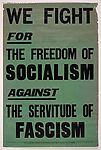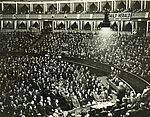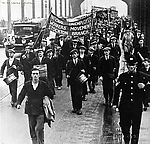 TUC anti-fascist poster, 1933
TUC anti-fascist poster, 1933 TUC anti-Nazi Demonstration, Albert Hall, April 1933
TUC anti-Nazi Demonstration, Albert Hall, April 1933 National Unemployed Workers' Movement March, 1933
National Unemployed Workers' Movement March, 1933 County Express 2/3/35
County Express 2/3/35

The recession of the 1930s was so severe that some people began to question the effectiveness of capitalism and of parliamentary government. In Britain and Europe, support for extremist groups increased, in the shape of the Communist Party of Great Britain (CPGB) on the extreme left, and the British Union of Fascists (BUF) on the extreme right.
The great hope for British fascism was the movement led by Sir Oswald Moseley. He saw himself as a second Mussolini. By 1934 he had recruited 50,000 members to his newly formed fascist party. However, the political situation in Britain was very different from the one in Italy that had permitted Fascists to seize power, and strong anti-Fascist feeling had been growing in Britain for some time. At a BUF rally at London’s Olympia, early in 1934, Fascist stewards attacked hecklers. This brought widespread condemnation, and by the end of 1935 membership had plummeted to just 5,000. A further blow came on October 4th 1936. A quarter of a million anti-Fascists gathered to stop a BUF march through the East End of London, home to Britain’s biggest Jewish community.
In 1937 BUF candidates stood in local elections, but did not win a single seat. During 1938 and 1939 the BUF campaigned for peace with Hitler, but attracted little support. The party remained small and isolated.
The CPGB was formed in 1920 with the aim of bringing about a workers’ revolution. Membership rose to 11,500 in 1926 following the General Strike, and the Party fielded 25 candidates in the 1929 general election. The Depression of the 1930s worked to the Communists’ advantage. The end of capitalism seemed near and their radical solution of a workers’ revolution had a sympathetic reception amongst working class men and middle class intellectuals. Membership never rose greatly, however, reaching only around 18,000 by the end of 1938.
Despite having limited success in the country as a whole, the CPBG was at the forefront of campaigns in support of the unemployed and against the Means Test. The Communist inspired National Unemployed Workers’ Movement (NUWM) , which was established in 1921, raised the plight of the unemployed through hunger marches, factory raids to protest against overtime working and mass demonstrations aimed in particular at Poor Law Guardians.
The TUC feared the Communist influence in the NUWM and called on trade councils to boycott its demonstrations. In 1933 it organised its own massive national demonstration against unemployment in 21 towns and cities throughout Britain. Its attitude to both Communists and Fascists was clear. The TUC’s first duty was, "to affirm its adherence to the democratic spirit, which has made its existence possible. It must oppose equally all dictatorships whether to the Right or to the Left."
Despite the activities of these extremist political groups, the National Government continued to have the support of the majority of people throughout the 1930s. Although some parts of the United Kingdom suffered appallingly from the effects of the depression, others saw the growth of new industries and new prosperity. Britain’s unemployment problem was much less acute than that in mainland Europe, and although there were many faults in Britain’s benefit system, it was enough to ensure that the unemployed were not the political tinder they became elsewhere.
Rollover the captions in the box to see the available images in thumbnail format, click the caption to see the full-size image
| Reference: | 719 |
| Keywords: | |
| Archive Ref: | |
| Updated: | Wed 9 Jul 2008 - 10 |
| Interpretation written by | Barbara Harris |
| Author's organisation | Curatorial |
| Organisation's website |